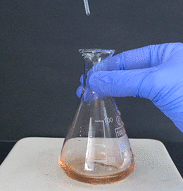An acid-base titration is the determination of the concentration of an acid by exactly neutralizing it using a base of known concentration (or vice versa). The endpoint of the titration is usually accentuated by the addition of an acid-base indicator to the sample being analysed.
Acid-Base Indicators
These are usually a large organic molecule, which are coloured differently in their dissociated and undissociated states. When dissolved in a solution the indicator will dissociate slightly, with the dissociated ions forming an equilibrium with the undissociated form of the indicator. This equilibrium position will be dependent on the hydrogen ion concentration of the solution and hence the colour observed will be pH dependent.
Indicators do not change colour abruptly, but rather over a range of hydrogen ion concentrations. This is defined as a pH transition range and is dependent on the indicator used.
Endpoint & Equivalence Point
The endpoint of an acid-base titration occurs when the indicator observably changes between its two forms (i.e. switches colours). For a particular acid-base pair this will vary between indicators since the colour transition range is indicator dependant.

The equivalence point of an acid-base titration is the pH when chemically equivalent quantities of the acid and base have been mixed. This will vary depending on the acid and base being used. For the case where acid is being added to a fixed starting volume of base, the following titration curves give an indication of what would typically be observed for strong/weak acid/base combinations:

NOTE: If the indicator used for an acid-base titration is selected such that its pH transition range brackets the equivalence point of the system being studied, the measured endpoint will closely relate to the equivalence point.